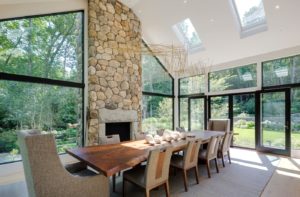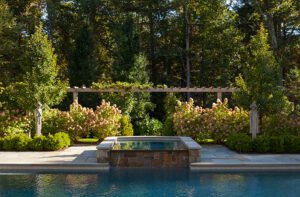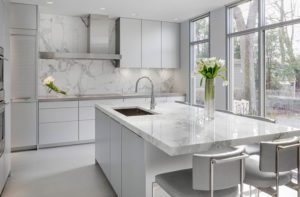A Restored Vermont Farmhouse
June 19, 2020
Text by Robert Kiener Photography by John Gruen Produced by Doretta Sperduto

While on the hunt for a weekend retreat, the first thing New Jersey-based interior designer Michael Maher thought when he walked into the small, nineteenth-century farmhouse in southern Vermont was, “I could live here.” As he explains, “The house hadn’t been improved in a long time—nearly half a century—but it still felt so comfortable, so charming, so welcoming. And, just as important, because it had such good bones, I knew I’d be able to renovate it without destroying its homey feel and look.”
He remembers one of the earliest changes he made: stripping the brick-red paint off the floors and sanding them. “I’ll never forget the thrill of finding that wonderfully preserved, gorgeous eight-to-nine-inch-wide yellow pine beneath all that garish red paint,” he says. “Right then, I knew I’d made the right choice.”
Maher used the 1850s two-bedroom dwelling as his vacation and weekend home/studio for several years before he “bit the bullet” and began a major renovation that would add a master bedroom, another bedroom, and two full bathrooms to the petite, clapboard-sided structure. (Maher now plans to retire to the space one day.)
Intent on retaining the home’s feel, he decided not to expand its modest twenty-foot-by-twenty-foot footprint. “I loved the way it blended into the land and didn’t want it to dominate it in any way,” he explains. He enlisted the help of Vermont-based architect William Badger, who is highly experienced in preserving historical properties. “Michael stressed that he wanted to maintain the home’s style and respect its history and integrity,” says Badger. He helped Maher put together a sympathetic plan that called for renovating the kitchen downstairs, and raising the roof to create room for the new bedroom and baths within the enlarged second story.
To maintain the cozy, comfortable feeling, Maher chose a lot of classic, even antique, pieces when he furnished it. “Antiques have so much character and are so interesting looking,” says the designer, who is an admitted Anglophile. “They have a beautiful patina and are not your run-of-the-mill showroom pieces but always add interest and depth to a setting.” Among his favorites are a nineteenth-century French refectory table in the dining or, as Maher calls it, mini-great room, seventeenth-century Basilius Besler botanical prints, an early nineteenth-century Swedish Mora longcase clock, nineteenth-century painted Swedish chairs, antique bird prints, and a Dutch burl wood mirror. “I’ve lived with some of these pieces for years and brought them here,” says Maher. “But I’ve been careful to make sure they fit in with the home’s relaxed, comfortable vibe.”
Although he confesses he doesn’t like the word, he agrees that his design style is often described as eclectic. To this end, he’s mixed modern, handmade Moroccan carpets, a brand-new sofa, and bold wall coverings in among the antiques. “I typically use a wide range of colors and patterns in my projects, and this house was no exception.”
The designer couldn’t resist adding one unexpected feature to the renovation: an outdoor shower. “Our builder was amazed and asked me, ‘You know you’re in Vermont?’ But I love it and, as I explained to him, I have ice in my veins!”
Renovation architecture: William Badger, Badger & Associates
Interior design and landscape design: Michael Maher, Michael Maher Design
Builder: Mark Davis
[WPSM_COLORBOX id=73546]
Share
![NEH-Logo_Black[1] NEH-Logo_Black[1]](https://www.nehomemag.com/wp-content/uploads/2022/08/NEH-Logo_Black1-300x162.jpg)

















You must be logged in to post a comment.